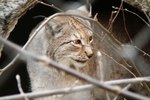
The classic black and white striped skunk is known as just that -- the "striped skunk" or "Mephitis mephitis." These small and furry nocturnal mammals are iconic not only for their conspicuous striped patterns, but also for their odoriferous and persistent spray, which they give off during times of fear and anxiety.
When Do Skunks Get Their Stripes?
Young skunks, which are referred to as "kittens," don't just wake up one morning with stripes out of nowhere. They actually are born with them, according to the Missouri Department of Conservation. Although newborn baby skunks mostly lack hair on their bodies, their stripes, oddly enough, already are prominent. Though the stripes already exist, the kittens are not very developed, and lack hearing and vision, too. The typical length of gestation for a striped skunk is approximately 77 days.
Stripes Pattern
Most of a striped skunk's coat is fully black. Striped skunks have a short and rather thin stripe on their faces, which runs between the forehead and just above the nose. Their longest stripes are rather specific in pattern, as they begin as a triangular form behind the head. The triangle then breaks out into two separate stripes that join together for a second time close to the tail's foundation.
Stripes Sizes
No two skunks' stripes look exactly the same. Some striped skunks have thicker stripes, while others have thinner ones, for example. Some also may have shorter or longer stripes than others. Sibling skunks may even look very different, stripes-wise. One wee skunk in a litter may appear practically free of stripes, while his brother may have especially thick and conspicuous ones. Skunk litters generally consist of between 5 and 6 young ones, all of which can have totally different patterns of stripes.
Other Types of Skunks
Striped skunks are by no means the only type of skunk; however, they are definitely the most prevalent species within North America, according to the Smithsonian Museum of Natural History. For example, the Eastern spotted skunk (Spilogale putorius) does not have standard stripes, but still is born with its own very obvious lined pattern.
References
- Illinois Department of Natural Resources: Striped Skunk
- Nature Works: Striped Skunk
- University of Michigan Animal Diversity Web: Mephitis mephitis
- FCPS: Striped Skunk
- New York State Department of Environmental Conservation: Striped Skunk
- PBS: Is That Skunk?
- Missouri Department of Conservation: Striped Skunk
- University of Michigan Animal Diversity Web: Spilogale puturius
Photo Credits
-
Jupiterimages/Photos.com/Getty Images




